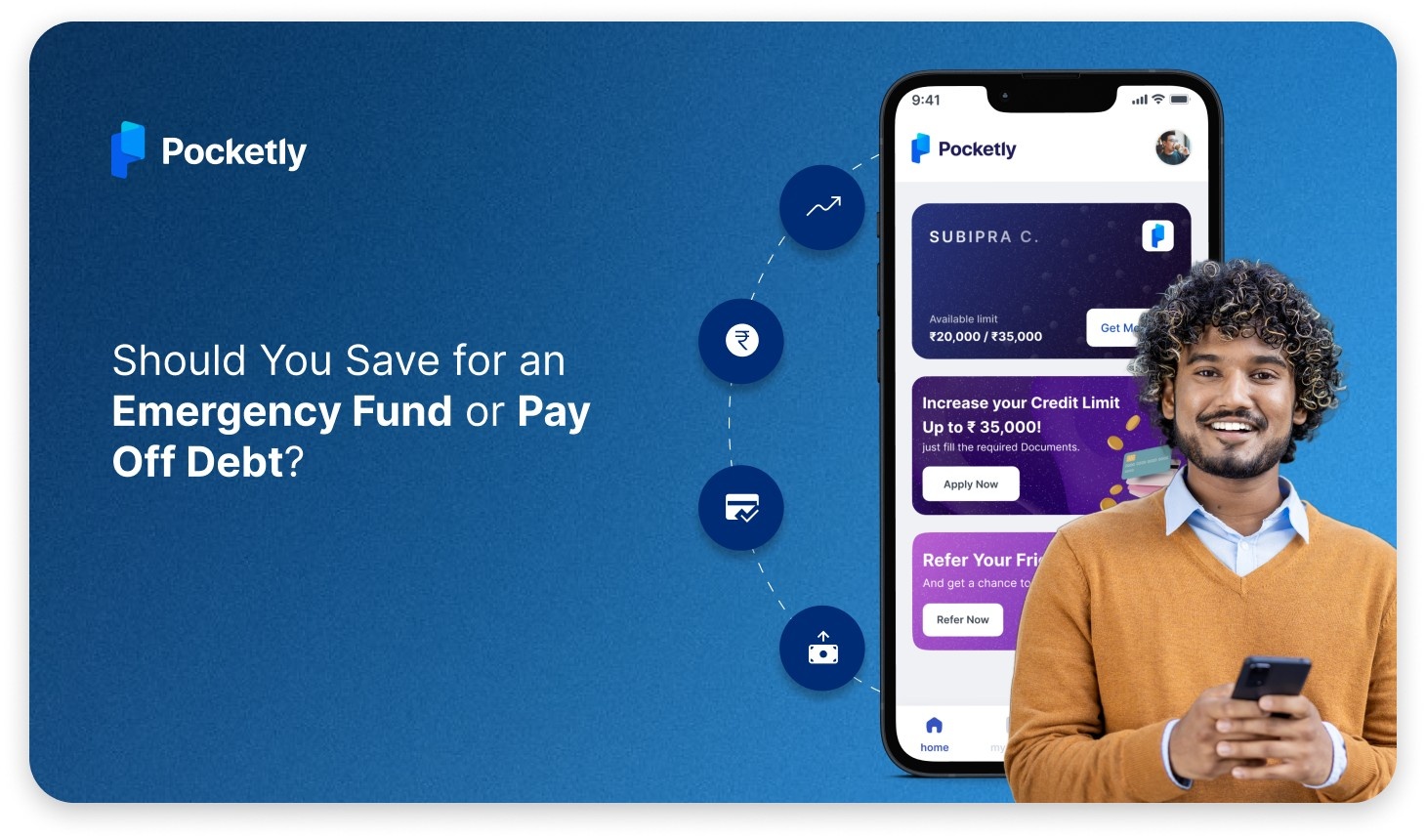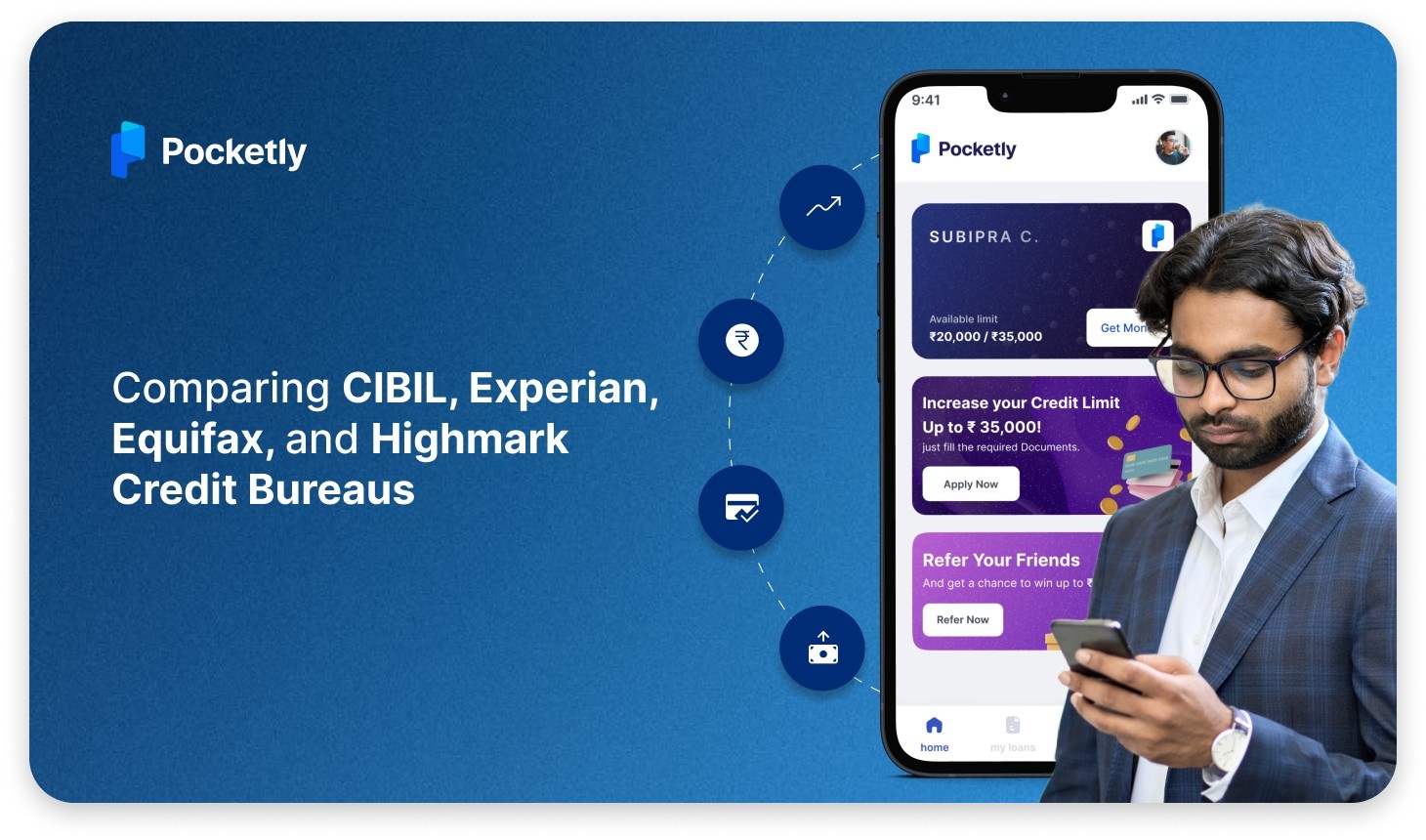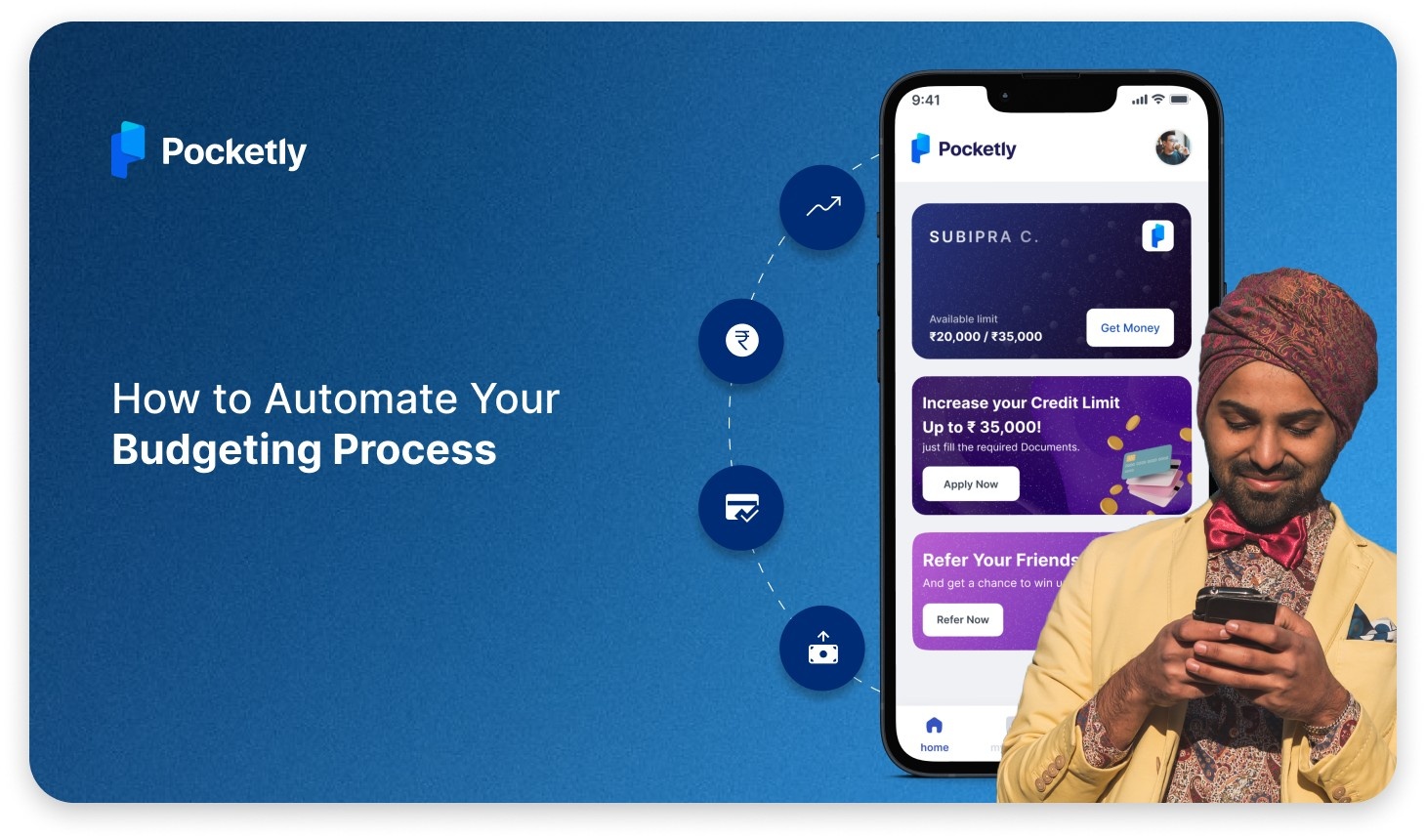
You’re not alone if managing your loans or credit card bills sometimes feels like a juggling act. In fact, did you know that household debt in India recently hit an all-time high, reaching 40% of the country's GDP as of December 2023? That’s a clear sign that many people are struggling to keep up with their repayments.
And here’s where things can get tricky. If you’re borrowing money just to pay off other debts, or finding it hard to keep up with EMIs, you could be slipping into what’s known as a debt trap.
So, what does that actually mean? Simply put, it’s when your debts grow faster than you can repay them, leading you into a cycle that feels impossible to break.
But don’t worry. In this blog, we’ll walk through the debt trap meaning, what causes it, the warning signs to watch out for, and most importantly, how to avoid it. Let’s get started.
What is a Debt Trap?
A debt trap is a financial situation where you find yourself stuck in a cycle of borrowing, taking on new debt just to repay existing loans. Over time, the repayments become more than what you can manage, and the interest keeps piling up.
It often starts with small loans or credit card usage. But when repayments aren’t made in full or on time, you begin relying on new loans or credit lines to keep up. The result? You’re constantly paying off debt without making real progress, and your financial stress keeps growing.
In short, a debt trap is when your debt becomes a burden, and escaping it feels harder with each passing month.
Why It’s Important to Understand a Debt Trap
- It helps you take control of your finances early on.
- Recognising the signs of a debt trap allows you to act before the situation worsens.
- It prevents long-term financial stress.
- Understanding how debt traps form helps you make better borrowing decisions and avoid anxiety over repayments.
- It protects your credit score.
- Getting behind on loan or credit card payments can damage your credit history, which makes it harder to access future loans at good rates.
- It encourages smarter budgeting and saving habits.
- Awareness of debt traps motivates you to stick to a budget and build an instant fund, so you’re not relying on loans for every unexpected expense.
- It keeps you from paying excessive interest.
- Knowing how debt accumulates helps you avoid high-interest borrowing that can quickly spiral out of control.
Now that we have understood what a debt trap is, let's explore what the indicators of falling into a debt trap are.
Indicators of Falling into a Debt Trap
A debt trap doesn’t happen overnight; it builds up slowly, often without you even realising it. That’s why spotting the early warning signs is so important. The sooner you recognise the red flags, the quicker you can take action to regain control of your finances.
Here are some clear indicators that you might be heading towards a debt trap:
- A large part of your income goes towards EMIs
- If your loan repayments take up most of your monthly salary, leaving little for savings or everyday expenses, it's a sign your debt is starting to overwhelm your budget.
- You’re borrowing just to cover regular expenses
- Taking out short-term loans or using credit cards for essentials like groceries, rent, or utility bills means your income isn’t enough to support your lifestyle.
- You’re only making minimum payments
- If you're only able to pay the minimum due on your credit card or loan, the principal amount stays the same while interest continues to grow.
- You often rely on new loans to repay old ones.
- Using one loan to cover another creates a dangerous cycle that’s hard to break and is a classic symptom of falling into a debt trap.
- You feel anxious or helpless about your financial situation.
- Constant stress, avoiding bills, or losing track of repayment schedules often means your debts are becoming too much to handle.
If any of these sound familiar, don’t panic, but don’t ignore them either. These signs are your cue to pause, review your finances, and take steps to protect yourself from getting stuck in a deeper financial hole.
Want a simple breakdown? Here’s how the debt trap cycle often starts:
| Step | Description |
|---|---|
| 1 | You take out one small loan. |
| 2 | Struggle to repay on time. |
| 3 | Use another loan or credit card to cover it. |
| 4 | Interest starts building. |
| 5 | EMIs take over your monthly income. |
| 6 | You borrow again just to stay afloat. |
And before you know it, you’re stuck in a loop that’s hard to escape.
Example: Imagine you take a ₹50,000 personal loan to cover a sudden expense. The EMI is manageable at first. But a few months later, you need to swipe your credit card for day-to-day expenses. You pay only the minimum due each month, and the interest keeps growing.
To stay on top, you take out another small loan. Now, you're paying EMIs on both loans and struggling to cover bills. You’ve entered a cycle where your debt keeps increasing, and you're borrowing more just to make it through the month.
5 Causes of Debt Traps
Debt traps don’t just appear out of nowhere—they usually build up slowly through a mix of financial habits, unexpected life events, and poor money management. Often, people don’t even realise they’re heading into one until it starts affecting their everyday life and peace of mind.
Understanding these causes is your first step toward preventing a financial spiral. Here's a breakdown of the most common reasons people fall into debt traps—and how you can avoid them.
1. Overspending and Lifestyle Inflation
What it is:
This happens when your expenses increase as your income rises. You might start upgrading your lifestyle by buying a new phone every year, dining out more, shopping online frequently, or moving to a more expensive apartment—even if your savings haven’t caught up.
Why it happens:
We often feel the urge to reward ourselves as our income grows. Social pressure, comparison with peers, or trying to match a certain lifestyle can push you to spend more than necessary. Credit cards and EMI offers make it even easier to overspend without feeling the pinch immediately.
Impact:
Even with a steady income, overspending leads to reduced savings and dependency on credit for everyday needs. Over time, these small debts pile up and can lead to a full-blown debt cycle.
How to prevent it:
- Set clear limits on discretionary spending.
- Stick to a monthly budget that allocates money for essentials, savings, and lifestyle expenses.
- Ask yourself before every purchase: Do I really need this, or do I just want it right now?
2. High-Interest Borrowing (Especially Credit Cards & Payday Loans)
What it is:
Taking loans with extremely high interest rates, often above 30–40% annually, is one of the fastest ways into a debt trap. Credit cards, payday loans, and quick-cash apps may seem convenient, but can become dangerous if not managed well.
Why it happens:
People often turn to these options in emergencies or when they can’t access formal loans due to a low credit score or lack of documentation. These lenders market themselves as "instant" solutions, while hiding the true cost of borrowing.
Impact:
The longer you delay repayment, the more your debt grows due to compound interest. Before you know it, you’re stuck making minimum payments that barely touch the principal amount.
How to prevent it:
- Use credit cards only if you can repay the full amount by the due date.
- Avoid payday loans and informal lenders; always choose regulated, transparent lenders.
- Build a good credit score so that you qualify for lower-interest loans when needed.
3. Lack of Financial Planning or Budgeting
What it is:
Living without a financial plan is like driving without a map. You might get where you're going, or you might end up lost and broke. When you don’t know how much you earn, spend, owe, or save each month, it’s easy to fall into financial imbalance.
Why does it happen?
Budgeting seems time-consuming, and many people believe it’s only for those with large incomes. Others simply don’t track their money until it's too late.
Impact:
Without a budget, you may overspend, under-save, miss EMIs, and borrow unnecessarily, all of which can push you toward a debt trap.
How to prevent it:
- Set aside time once a month to track your income and expenses.
- Use simple tools like Google Sheets, budget planners, or mobile apps.
- Allocate specific percentages for essentials (50%), savings (20%), and lifestyle (30%) as a starting point.
4. Lack of Emergency Fund
What it is:
An emergency fund is a financial buffer that protects you from unplanned expenses, like a hospital bill, job loss, or urgent car repair. Without it, even a single emergency can derail your finances.
Why does it happen?
Many people live paycheck to paycheck and delay saving until "next month." Others underestimate the need for emergency savings because everything seems fine—until it’s not.
Impact:
Without a backup, you’re forced to borrow—often at high interest—just to cover urgent expenses, starting a chain of repayments and interest that can spiral quickly.
How to prevent it:
- Start small. Saving even ₹500 or ₹1,000 a month adds up over time.
- Keep a goal of 3 to 6 months’ worth of basic expenses in a separate savings account.
- Automate your emergency savings to ensure consistency.
5. Multiple Loans at the Same Time
What it is:
Handling two or more loans—like a home loan, car loan, personal loan, and credit card bills can be difficult, especially if your income hasn’t increased in proportion to your liabilities.
Why does it happen?
Attractive loan offers, pre-approved limits, and easy access to credit can lead people to take on more debt than they can realistically manage.
Impact:
Too many EMIs can eat up your monthly income, leaving you with little room for savings or emergencies. Missed payments might affect your credit score and result in late fees and penalties.
How to prevent it:
- Evaluate your repayment capacity before taking on new loans.
- Limit your borrowings to what you can repay comfortably, even in a bad month.
- If managing multiple debts feels overwhelming, consider debt consolidation to combine them into one loan with a lower interest rate.
By identifying these causes and being proactive with your finances, you can avoid falling into the debt trap and instead build a stronger, more secure financial future. It's all about awareness, planning, and staying one step ahead.
To understand more about financial planning, Understanding the Basics of Financial Planning and Its Importance.
Strategies to Avoid Debt Traps
Debt traps can be avoided with the right habits and a bit of planning. It’s not about never taking a loan, but about borrowing smartly, managing your money well, and being prepared for the unexpected. By following a few simple strategies, you can stay in control of your finances and keep debt from becoming a burden.
Here are some practical ways to stay out of the debt trap:
- Create a realistic monthly budget and stick to it
- Knowing exactly where your money goes helps you avoid unnecessary spending. Allocate funds for essentials, savings, and flexible spending, and review your budget regularly.
- Build an emergency fund to handle unexpected expenses
- Set aside money each month in a separate savings account. Even a small emergency fund can protect you from having to rely on high-interest loans when life throws you a curveball.
- Avoid high-interest loans and unnecessary borrowing
- Think twice before taking out quick loans, payday advances, or borrowing for non-essential items. Always compare interest rates and terms before signing any loan agreement.
- Use credit cards responsibly
- Only spend what you might repay in full by the due date. Avoid carrying a balance from month to month, as credit card interest rates are very high.
- Automate your bill and EMI payments
- Set up auto-debits for your loan repayments and utility bills to ensure you never miss a due date. This helps you avoid late fees and protects your credit score.
- Track your debt regularly and reassess your financial position
- Keep a list of all your loans, EMIs, and credit card balances. Regularly reviewing your repayment obligations helps you plan better and avoid overborrowing.
- Say no to lifestyle inflation
- Just because your income increases doesn’t mean your spending should too. Save and invest a portion of your additional income instead of upgrading your lifestyle with every pay rise.
By following these strategies, you can protect yourself from falling into a debt trap and create a financial cushion that keeps you stable even in uncertain times.
Benefits of a Strong Financial Plan
Having a strong financial plan isn’t just about tracking numbers—it’s about giving yourself peace of mind, control over your money, and the freedom to make better choices. When you plan and stay financially organised, you’re far less likely to fall into a debt trap or struggle with repayments.
Here’s how a solid financial plan can make a real difference in your life:
- It ensures you make timely repayments on loans and bills
- With a clear plan in place, you know exactly when payments are due and how much you can afford, helping you avoid late fees and maintain a healthy credit score.
- It reduces financial stress and anxiety
- Understanding that you’ve got a plan (and a backup fund) helps you feel more in control, even during emergencies or tough months.
- It keeps you from relying on high-cost borrowing
- With savings and proper budgeting, you’re less likely to turn to credit cards or payday loans to manage unexpected costs.
- It improves your financial health and stability
- A well-structured plan helps you save more, spend smarter, and work toward goals like buying a home, travelling, or retiring comfortably.
- It strengthens your decision-making ability
- When you have a financial roadmap, it’s easier to evaluate loan offers, spending choices, and investment opportunities without second-guessing.
- It builds discipline and long-term habits
- Regular saving, budgeting, and reviewing your finances builds a foundation for future success and keeps you from falling back into poor money habits.
A strong financial plan is like a safety net; it won’t stop unexpected things from happening, but it makes sure you land on your feet when they do.
Role of Professional Help in Avoiding Debt Traps
Sometimes, no matter how hard you try, managing your debts can feel overwhelming. And that’s perfectly okay. Seeking professional help doesn’t mean you’ve failed, it means you’re taking a smart step toward getting back on track. Experts can offer personalised advice, negotiation support, and strategies you might not think of on your own.
Here’s how professional support can make a big difference:
- Debt counselling services can help you create a clear budget and repayment plan
- Trained financial counsellors might look at your income, expenses, and debt obligations to help you build a customised plan that’s realistic and manageable.
- Professionals can negotiate with creditors on your behalf
- If you’re struggling with repayments, experts can speak to lenders and try to arrange lower interest rates, extended tenures, or revised EMIs, making the debt more affordable for you.
- They help you understand when and where to seek help
- Sometimes just talking to a professional can help you see your situation more clearly. They’ll help you assess if you're heading toward a debt trap and guide you on the best steps forward, whether it’s refinancing, consolidating, or budgeting better.
Getting help when you need it isn’t a setback, it’s a smart step toward gaining control of your finances. And if you ever find yourself needing quick financial support in an emergency, Pocketly is here to make it easier. With instant approvals, low-interest rates, and a hassle-free process, it’s the kind of backup you can count on when it matters most.
Why Pocketly is the Best Choice for Instant Personal Loans
- Instant Approvals & Quick Disbursal – Need cash fast? With Pocketly, your loan gets approved within minutes, and the money is credited to your account almost instantly.
- Flexible Loan Amounts – Whether it’s a small emergency expense of ₹1,000 or a bigger need of up to ₹25,000, Pocketly offers loan options that fit your requirements.
- Minimal Documentation – No lengthy paperwork or complicated forms. Just submit basic KYC documents, and you're good to go!
- Transparent Fees – No hidden charges or surprises. You’ll know your interest rates and processing fees upfront so that you can plan your repayments easily.
- No Credit Score Barriers – Even with a low or limited credit score, Pocketly gives you a fair chance to access funds, unlike traditional banks that may reject your application.
- Flexible Repayment Options – Get a repayment plan that fits your budget, making loan repayments stress-free and manageable.
With Pocketly, you get a hassle-free borrowing experience that’s quick, transparent, and tailored to your needs, just the way it should be!
To learn more about applying for a mini personal loan, Instant Access to Mini Personal Loan of Rs 10000.
Conclusion
Falling into a debt trap can feel like sinking sand—the harder you try to fix things without a plan, the deeper you might go. But the good news? It’s not permanent. With the right habits, a solid financial plan, and timely support, you can avoid getting caught in the cycle, or even climb your way out of one.
It all starts with being aware, keeping an eye on your spending, making smart borrowing decisions, and not being afraid to ask for help when things feel overwhelming.
And remember, you don’t have to face financial stress alone. If you're ever in need of quick, reliable support, Pocketly can be your financial buddy. Whether it’s covering an emergency or bridging a short-term gap, Pocketly’s instant personal loans come with low interest and flexible terms so that you can stay on top of your finances without the pressure.
Take control today, because peace of mind is just as important as paying off that next EMI.
FAQs
How can I improve my CIBIL score for better credit cards?
Pay bills on time, keep credit utilisation below 30%, avoid frequent credit applications, and check your report for errors.
Can I get a credit card without a credit history?
Yes, try a secured credit card, add-on card, or entry-level card designed for first-time users.
What loan amounts can I apply for?
You can borrow ₹1000 to ₹25,000, depending on your eligibility and needs. It’s perfect for covering small and urgent expenses.
What documents are needed?
Only basic KYC documents—PAN card, Aadhaar card, and bank statement—all uploaded online. You don’t need to deal with any physical paperwork.
Do I need a credit score?
No credit score is required. Pocketly welcomes first-time borrowers, too. It’s designed for everyone, including those new to credit.
What are the repayment options?
Flexible EMIs allow you to choose a repayment plan that fits your budget. You’ll have complete control over how you repay.

















